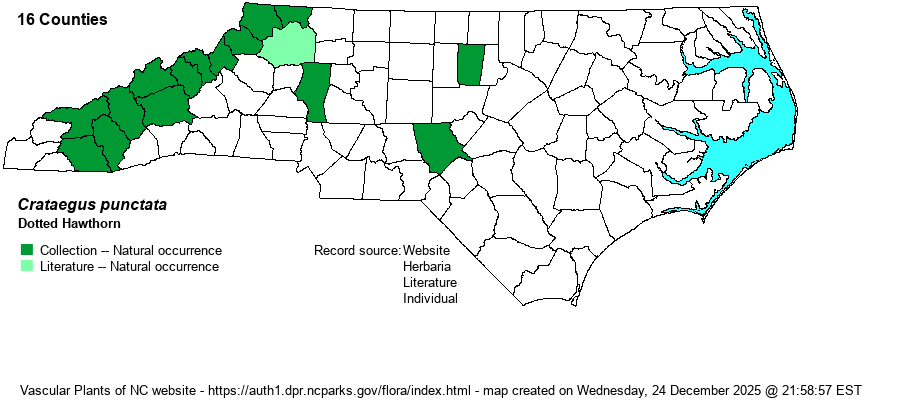| Author | Jacquin | |
| Distribution | Generally throughout the Mountains, at least at higher elevations, but very widely scattered into the Piedmont east to near the Fall Line. Not present in the Coastal Plain, and perhaps absent in the far southwestern montane counties (Cherokee, Clay, and Graham). As this is a long-standing valid species, the range map below should be taken as reasonably accurate, with only a few valid county records east of the Mountains.
This is a Northern species, ranging from southern Canada south to the mountains of NC and TN. In the central Atlantic states it is found mainly in the mountains. Note that the range map on BONAP is incorrect, and certainly includes other species; this species does not occur in SC, GA, AL, MS, etc., according to Weakley (2018). | |
| Abundance | Uncommon to infrequent, to locally numerous (as it can occur in thickets), in the higher Mountains, but rare at low elevations there and into the Piedmont. | |
| Habitat | This is a characteristic species (in NC) of high elevation pastures, thickets, grassy balds, rock outcrop margins, and other open or disturbed sites, but it can grow inside such high elevation forests. Dense or large stands of a hawthorn growing on a high, exposed mountaintop or grassy bald are often this species. | |
| Phenology | Blooms in May, and fruits from September to October. | |
| Identification | This is the largest hawthorn in stature in NC, with a crown up to 30-40 feet tall and much wider and fuller than tall. Trees often have a horizontal layering of branches. The leaves are widely ovate to nearly elliptic, to nearly rhombic; the bases are entire and gradually cuneate to the petiole, but the distal half is widely rounded and somewhat evenly toothed, almost always lacking lobes. Also distinctive are the 6-9 pairs of deeply impressed, parallel veins on the upper sides of the leaves. Though the name comes from the dots on the fruit, other hawthorns can have this mark; the fruit do often remain on the trees well after leaf-fall in late autumn. As Weakley (2018) states: “C. punctata, often in company with C. macrosperma, comprises the majority of hawthorn forests, 'orchards,' and thickets seen in the high elevations of the North Carolina Blue Ridge, in openings and disturbed Picea rubens [Red Spruce] and Abies fraseri [Fraser Fir] forests.”
| |
| Taxonomic Comments | None
| |
| Other Common Name(s) | None | |
| State Rank | S3 | |
| Global Rank | G5 | |
| State Status | | |
| US Status | | |
| USACE-agcp | | |
| USACE-emp | | |

